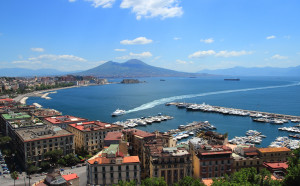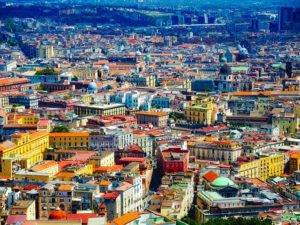
 Naples
Naples![]() its steps. There is nothing better to represent the strong contrasts of the city than a walk down the 200 steps hidden among the alleys steeped in history and the fragrances wafting from the kitchens that accompany us on our journey. Wide steps that connect the historic centre and the sea, with the more ‘regal’ neighbourhoods, the Posillipo hill
its steps. There is nothing better to represent the strong contrasts of the city than a walk down the 200 steps hidden among the alleys steeped in history and the fragrances wafting from the kitchens that accompany us on our journey. Wide steps that connect the historic centre and the sea, with the more ‘regal’ neighbourhoods, the Posillipo hill![]() and the Vomero
and the Vomero![]() . ‘Scalinatella’
. ‘Scalinatella’![]() as the song from the classical repertoire sounds, a favourite of Massimo Troisi, to whom the staircase located between Via Francesco Crispi and Piazza Roffredo Beneventano, in Via Chiaia
as the song from the classical repertoire sounds, a favourite of Massimo Troisi, to whom the staircase located between Via Francesco Crispi and Piazza Roffredo Beneventano, in Via Chiaia![]() , known to all thanks to the memorable scene in ‘Sorry I’m late’, was recently dedicated.
, known to all thanks to the memorable scene in ‘Sorry I’m late’, was recently dedicated.
Don’t worry, this time we won’t walk down all the two hundred steps in Naples, but only four of the most representative ones.
An important meeting, Anna Maria Cicellyn of Legambiente Napoli Centro Antico explains: ‘Among the most interesting routes for tourists who are not satisfied with just pizza and mandolins. Ancient, still inhabited places where it is possible to capture scenic beauty, moments in the life of Neapolitans and the history of the city.
 Contrasting visions of bucolic glimpses and teeming city in a continuous up and down between stones, castles, houses, basses, ravines, smells, citrus groves, handkerchiefs of vegetable gardens. And then the sea in the distance, with its thousand shades. These are the places of the heart’.
Contrasting visions of bucolic glimpses and teeming city in a continuous up and down between stones, castles, houses, basses, ravines, smells, citrus groves, handkerchiefs of vegetable gardens. And then the sea in the distance, with its thousand shades. These are the places of the heart’.
An ancient path, because most of these high blocks were built between the 16th and 17th centuries. The streets of the ‘scugnizzi’s games. The children of the Petraio were already mentioned in the film ‘The Four Days of Naples’ by Nanni Loy. And it is precisely from the Petraio that we will start.
For the less energetic, we recommend the funicular railway, where we remind you that bicycles are allowed.
Funicular Chiaia: station Palazzolo-Parco Marcolini (Via Filippo Palizzi and Via Gioacchino Toma); Funicular Centrale: station Petraio-Via Palizzi (Salita del Petraio and Via Filippo Palizzi).
From the Piazza Garibaldi station, you can take the underground, Line 2 towards Pozzuoli, or the C16 bus.

The name ‘Petraio’ derives from the fact that during heavy rains, pebbles and muddy stones came down. From Corso Vittorio Emanuele, at the height of the church of San Carlo alle Mortelle, we climb the stairs to the Vomero. And from Vomero, from Via Annibale Caccavello, we reach San Martino, from where ‘you see the whole city’, to quote a famous song by Pino Daniele, here we find the Pedamentina.
The steps are 414 and connect the Certosa di San Martino![]() to the historic city centre, and we get to know Spaccanapoli
to the historic city centre, and we get to know Spaccanapoli![]() . So from uptown we dive once more into the heart of the city. Are you tired? If you want to stop there, you will find the B&B La Pedamentina, opened by Pasquale Nocerino, who is a violinist, with his wife Giovanna, a classical dancer. la Pedamentina was also known to Baudelaire, where he stayed for a while, and it was here that Marguerite Yourcenar set her ‘Anna soror’.
. So from uptown we dive once more into the heart of the city. Are you tired? If you want to stop there, you will find the B&B La Pedamentina, opened by Pasquale Nocerino, who is a violinist, with his wife Giovanna, a classical dancer. la Pedamentina was also known to Baudelaire, where he stayed for a while, and it was here that Marguerite Yourcenar set her ‘Anna soror’.

But if you are not tired and want to continue, we can continue because this is only the beginning of our urban trek. Cutting through Via Duomo we have to get to Via Foria and go up, up again. First the Montagnola stairs, do you remember the film ‘Yesterday, Today and Tomorrow’? Well those are the stairs where Sofia Loren used to sell contraband cigarettes. Then we will find another important staircase in Naples is the Moiariello, a name derived from Moggio, an agricultural unit of measurement, hence the typical landscape of ancient villages. Climbing up the hill we reach one of the most beautiful destinations in Naples, the Capodimonte![]() wood, ideal for taking a rest in nature and visiting the museum where you can also admire contemporary works of art. Here is Vesuvius by Andy Warhol, with which the artist paid homage to Naples.
wood, ideal for taking a rest in nature and visiting the museum where you can also admire contemporary works of art. Here is Vesuvius by Andy Warhol, with which the artist paid homage to Naples.
Alternative route for those who are fond of public transport: From Via Foria you can get to Piazza Cavour to the station of the same name from which, via the underground treadmill, you can get to the Museum Station, continue by bus C63, which stops at Porta Grande, Parco di Capodimonte or 2M or 178, arriving at Porta Piccola in Parco di Capodimonte.
And not far from the Capodimonte Museum, about 4 km, in Chiaiano, we can visit the Fondo Rustico Amato Lamberti. This was the first agricultural land in Naples confiscated from the clans, from the Simeoli(Nuvoletta) family. Today it is cared for by the Resistenza cooperative, 14 hectares of vineyards and peach orchards, where it is possible to participate in the many activities for legality, including grape picking for the Falanghina Anticamorra. Here it is also possible to spend the night with sleeping bags and tents in summer, while in winter it is possible to find accommodation at the Officina delle Culture “Gelsomina Verde” with a b&b formula, located in Scampia on via Ghisleri, also run by the Resistenza cooperative.

With Christmas approaching, you cannot miss a visit to San Gregorio Armeno![]() famous throughout the world for its splendid nativity scenes, unique works of art.
famous throughout the world for its splendid nativity scenes, unique works of art.
From Piazza Garibaldi![]() l station you can take the R2 bus and get off right in front of the Federico II University.
l station you can take the R2 bus and get off right in front of the Federico II University.
Continuing along via Mezzocannone![]() and the streets of the historical centre, you will find the streets of youth gatherings, Piazzetta Nilo, full of places where you can enjoy a break and continuing finally to visit the famous street of nativity scenes. Continuing on to Spaccanapoli, if your guide is experienced you can cut through the streets and lanes of musicians and the Port’Alba street of books, from Piazza Dante to Via Toledo
and the streets of the historical centre, you will find the streets of youth gatherings, Piazzetta Nilo, full of places where you can enjoy a break and continuing finally to visit the famous street of nativity scenes. Continuing on to Spaccanapoli, if your guide is experienced you can cut through the streets and lanes of musicians and the Port’Alba street of books, from Piazza Dante to Via Toledo![]() . At worst, you will land at the University of
. At worst, you will land at the University of

Architecture and cross over to Piazza Municipio, where you can admire the Maschio Angioino![]() , one of the symbols of the city.
, one of the symbols of the city.
Here there is ample parking for cars, the area is also provided with free wi-fi by the Municipality. Not far away is the molo Beverello![]() , landing stage for connections to the islands of Capri and Ischia.
, landing stage for connections to the islands of Capri and Ischia.
Skirting the castle and the National Library![]() and the San Carlo theatre
and the San Carlo theatre![]() , opposite is the Galleria Principe Umberto, where it is almost a ritual to taste sfogliatella from the Mary pastry shop.
, opposite is the Galleria Principe Umberto, where it is almost a ritual to taste sfogliatella from the Mary pastry shop.
The Galleria faces Via Toledo, popularly known as Via Roma, a coffee at the Gambrinus bar and we are in Piazza Plebiscito![]() . From here you can’t miss a stroll along the seafront on Via Caracciolo
. From here you can’t miss a stroll along the seafront on Via Caracciolo![]() .
.
